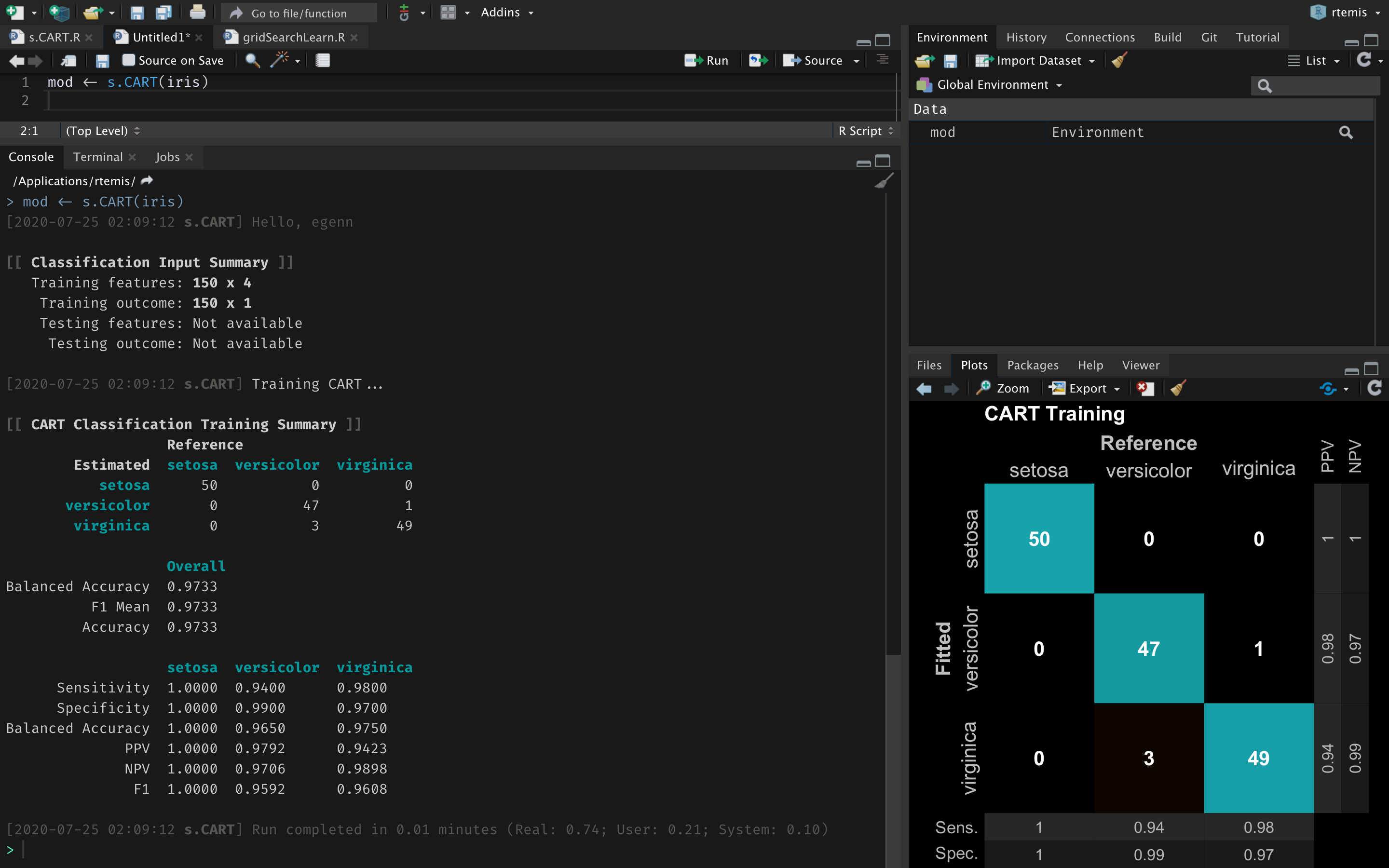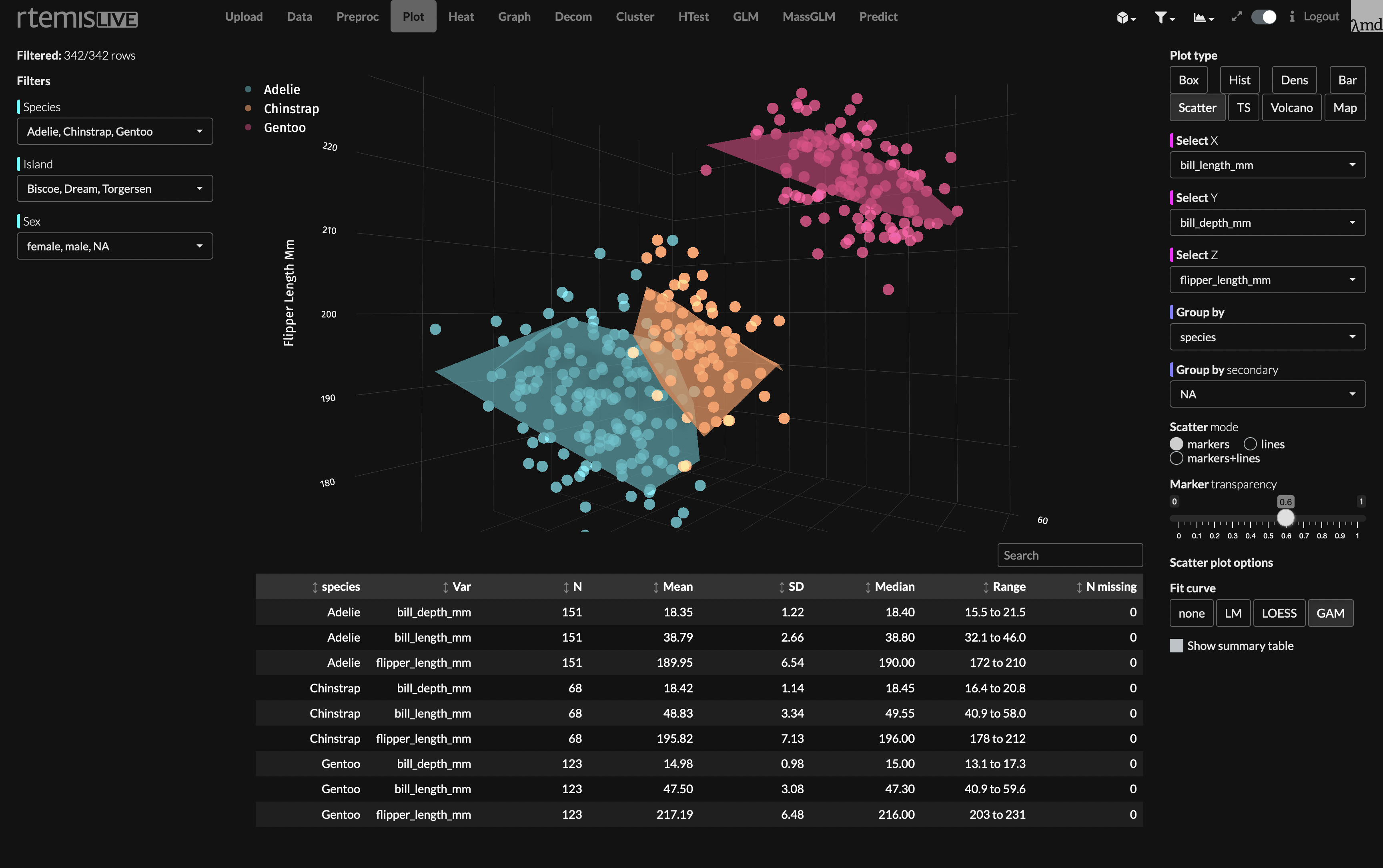rtemis Machine Learning and Visualization
A platform for advanced Machine Learning research and applications.
The goal of rtemis is to make data science efficient and accessible with no compromise on flexibility.
Documentation
Requirements
R version 4.1 or higher
Installation
Install rtemis usikg pak, remotes, or devtools:
pak::pkg_install("egenn/rtemis")or
remotes::install_github("egenn/rtemis")or
devtools::install_github("egenn/rtemis")See here for more setup and installation instructions.
Note: Make sure to keep your installation updated by running
remotes::install_github("egenn/rtemis") regularly: it will only proceed if
there are updates available.
30-second intro to rtemis
Install dependencies if they are not already installed:
packages <- c("future", "ranger")
.add <- !packages %in% installed.packages()
install.packages(packages[.add])Get cross-validated random forest performance on the iris dataset:
library(rtemis)
mod <- train(iris)What's new
We are working towards the 1.0 release, which will feature updates to the API as well as the backend, and preparing for CRAN submission. This will be accompanied by expansion of the documentation.
The Python and Julia ports, rtemispy and Rtemis.jl, which are not yet
publicly available, are in parallel development. With the upcoming 1.0 release
of rtemis, the aim is to offer a unified API across all three languages.
0.95.5
- Transition to
train()complete; elevate()andelevate1()` removed - Updated
s_LightGBMands_LightRuleFitfor better handling of categorical variables - Updated tests
- General cleanup in preparation for 1.0 release & CRAN submission
0.95.0 in rcpp branch
Adding support for Rcpp.
0.91
Switched the main parallelizable functions (resLearn for outer resamples;
gridSearchlearn for inner resamples) to use future for parallelization
and progressr for progress reporting.
0.90
Multiple additions and updates.
Major change: Renamed modeling and visualization functions to substitute
dots with underscores:
- Supervised learning:
s.=>s_ - Decomposition:
d.=>d_ - Clustering:
u.=>c_ - Cross-decomposition:
x.=>x_ - Static graphics:
mplot3.=>mplot3_;mplot.=>mplot_;gplot3.=>gplot3_ - Interactive graphics:
dplot3.=>dplot3_
0.82
- Themes: New darkgray theme now always on whether you like it or not - jk:
it's the new default but you can always set your own default using
e.g.
options(rt.theme = "lightgrid"). Also, newlightgraytheme. - New option to set default plotting font: e.g.
options(rt.font = "Inter") - Many improvements / additions to
dplot3*functions. - Plenty more I haven't had a chance to document here
0.80.0
An accumulation of updates and added functionality, algorithms, graphics.
Majority of mplot3 and dplot3 functions now work with the new theme system
provided by theme_* functions like theme_lightgrid and theme_darkgrid.
0.79
07-02-2019: "Super Papaya" Release out
0.78
04-02-2019: rtemis moved to public repo
Features
-
Visualization
- Static: mplot3 family (base graphics)
- Dynamic: dplot3 family (plotly)
-
Unsupervised Learning
- Clustering: c*_
- Decomposition: d*_
-
Supervised Learning
- Classification, Regression, Survival Analysis: s*_
-
Cross-Decomposition
- Sparse Canonical Correlation / Sparse Decomposition: x*_
-
Meta-Models
- Model Stacking: metaMod()
- Modality Stacking: metaFeat()
- Group-weighted Stacking: metaGroup()
(metaFeat and metaGroup have been removed for updating)
rtemislive
rtemislive is rtemis' web interface / GUI. It makes advanced visualization and modeling instantly accessible by all. It is currently available for beta testing at UCSF, and will be made publicly available once funding is secured for a hosting server.
VS Code theme
Get the rtemis-dark VS Code theme.
Recommended font is Fira Code with its pretty ligatures.



